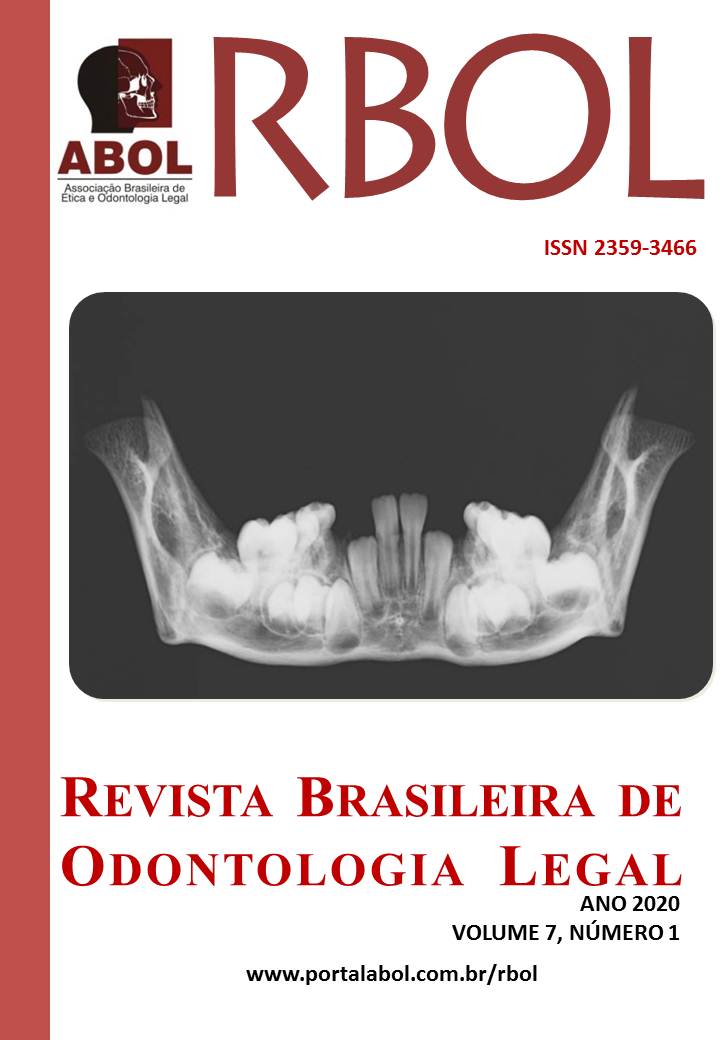ETHICAL AND LEGAL ASPECTS OF THE USE OF FAKE DRUGS FOR OROFACIAL AESTHETICS – A CASE REPORT
DOI:
https://doi.org/10.21117/rbol-v7n12020-300Palavras-chave:
Botulinum Toxin, Drug, Ethics, Forensic DentistryResumo
Introduction: Over the last decade, Botulinum Toxin (BT) gained space in the armamentarium of drugs used for orofacial aesthetics. The contemporary scenario of Dentistry led to new horizons within aesthetic treatments founded on the application of BT. Objective: This study aimed to report a case of fake type-A BT sold to a dentist on training for orofacial aesthetics. Material and methods: During a 16-hour training course, a dentist bought form a reference seller a “so-called” quality drug allegedly consisting of type-A BT. After suspecting of fake drug based on uncommon label and flask, the dentist sent images of the product to the laboratory responsible for registering the drug at the National Health Surveillance Agency (ANVISA). Results: The laboratory confirmed the fake drug. ANVISA blocked the commercialization, use and distribution of the product as well as made efforts to remove the available products from the market. Parallel police investigations were carried out and forensic expertise for drug profiling was accomplished – confirming the fake drug. Conclusion: This study drives attention to the possibility of existing fake drug commercialization to dentists dedicated to orofacial aesthetics, and the potential impact of this drugs if used in patients. Consequences might extend to penalties in the consumer relation interface, as well as in the criminal field as offense against public health.
Referências
Ozcakir S, Sivrioglu K. Botulinum toxin in poststroke spasticity. Clin Med Res. 2007 ;5(2):132–138. http://doi.org/10.3121/cmr.2007.716
De Boulle K, Fagien S, Sommer B, Glogau R. Treating glabellar lines with botulinum toxin type A-hemagglutinin complex: A review of the science, the clinical data, and patient satisfaction. Clin Interv Aging. 2010; 5:101–118 http://doi.org/10.2147/cia.s9338
Verderio C, Rossetto O, Grumelli C, Frassoni C, Montecucco C, Matteoli M. Entering neurons: botulinum toxins and synaptic vesicle recycling. EMBO Rep. 2006 ;7(10):995–999. http://doi.org/10.1038/sj.embor.7400796
Franco A. Forensic D
entistry 2nd ed. – book review. Rev Bras Odontol Legal RBOL. 2016; 3(2):138–141. http://doi.org/10.21117/rbol.v3i2.16
Brasil. Resolution CFO-198/2019 – establishes orofacial harmonization as a dental especialty. Brasília: Conselho Federal de Odontologia; 2019.
Moreira DC, Possidônio FS, De Souza FS, Kinoshita AMO, Silveira EMV. Application of botulinum toxin type A in gummy smile: case report. Rev Gauch Odontol RGO. 2019; 67:e20190013. http://doi.org/10.1590/1981-86372019000133555
Long H, Liao Z, Wang Y, Liao L, Lai W. Efficacy of botulinum toxins on bruxism: an evidence-based review. Int Dent J. 2012; 62(1):1-5. http://doi.org/10.1111/j.1875-595X.2011.00085.x
Srivastava S, Kharbanda S, Pal US, Shah V. Natl J Maxillofac Surg. Applications of botulinum toxin in dentistry: A comprehensive review. Natl J Maxillofac Surg. 2015; 6(2):152–159. http://doi.org/10.4103/0975-5950.183860
Ataran R, Bahramian A, Jamali Z, Pishahang V, Barzegani HS, Sarbakhsh P, et al. The role of botulinum toxin a in treatment of temporomandibular joint disorders: a review. J Dent (Shiraz). 2017; 18(3):157–164.
Silva RF, Prado MM, Oliveira HCM, Portilho CDM, Daruge Júnior E. Legal analysis of the instructions for use information in the K-Files packages. RSBO. 2010;7(2):200–207.
Silva RF, Prado MM, Oliveira HCM, Portilho CDM, Freitas GC, Daruge Júnior E. Legal analysis of K-File package. Part I – information about manufacturers, importers and product features. Rev Odontol UNESP. 2008;37(4):337–343.
Brasil. Resolução CFO-112/2011 – baixa normas para a utilização do uso da toxina botulínica e ácido hialurônico. Brasília: Conselho Federal de Odontologia; 2011.
Brasil. Resolução CFO-145/2014 – altera a redação de artigos da resolução CFO 112/2011. Brasília: Conselho Federal de Odontologia; 2014.
Brasil. Resolução CFO-146/2014 – altera o artigo 2o da resolução 112/2011. Brasília: Conselho Federal de Odontologia; 2014.
Brasil. Resolução CFO-176/2016 – revoga as Resoluções CFO-112/2011, 145/2014 e 146/2014, referentes à utilização da toxina botulínica e preenchedores faciais, e aprova outra em substituição. Brasília: Conselho Federal de Odontologia; 2016.
Brasil. Federal Law 5.081/66 – regulates dental practice in Brazil. Brasília: National Congress of Brazil; 1966.
Coleman K, Zilinskas RA. Fake botox, real threat. Scientific American. 2010;302(6):84-89. http://doi.org/10.1038/scientificamerican0610-84.
Downloads
Publicado
Edição
Seção
Licença
Os autores deverão encaminhar por email, devidamente assinada pelos autores ou pelo autor responsável pelo trabalho, a declaração de responsabilidade e transferência de direitos autorais para a RBOL, conforme modelo abaixo.
DECLARAÇÃO DE RESPONSABILIDADE E TRANSFERÊNCIA DE DIREITOS AUTORAIS
Eu (Nós), listar os nomes completos dos autores, transfiro(rimos) todos os direitos autorais do artigo intitulado: colocar o título à Revista Brasileira de Odontologia Legal - RBOL.
Declaro(amos) que o trabalho mencionado é original, não é resultante de plágio, que não foi publicado e não está sendo considerado para publicação em outra revista, quer seja no formato impresso ou no eletrônico.
Declaro(amos) que o presente trabalho não apresenta conflitos de interesse pessoais, empresariais ou governamentais que poderiam comprometer a obtenção e divulgação dos resultados bem como a discussão e conclusão do estudo.
Declaro(amos) que o presente trabalho foi totalmente custeado por seus autores. Em caso de financiamento, identificar qual a empresa, governo ou agência financiadora.
Local, data, mês e ano.
Nome e assinatura do autor responsável (ou de todos os autores).

